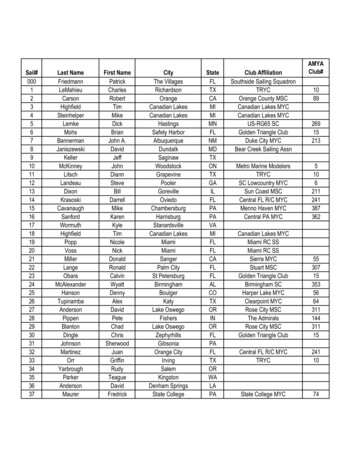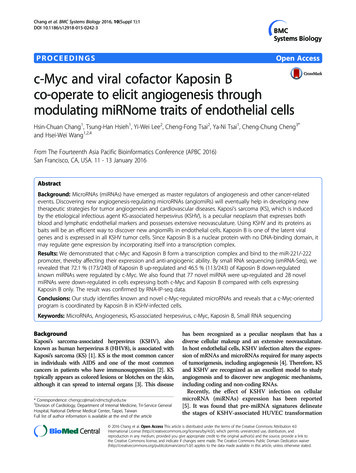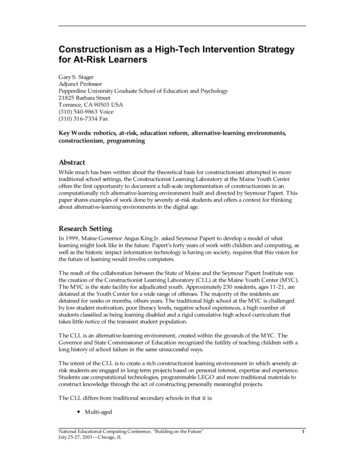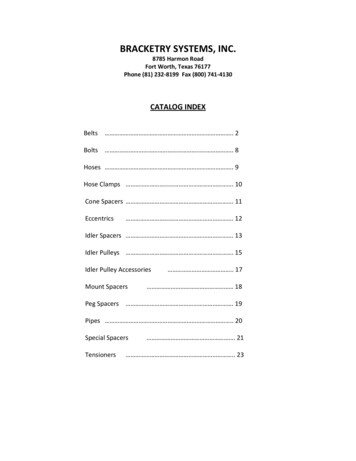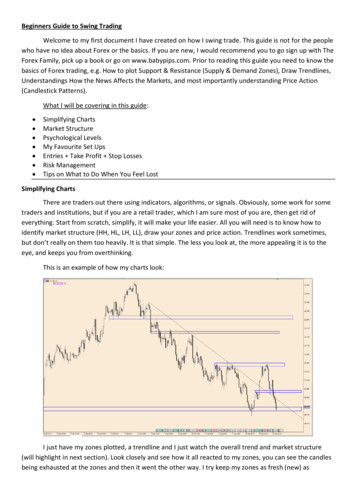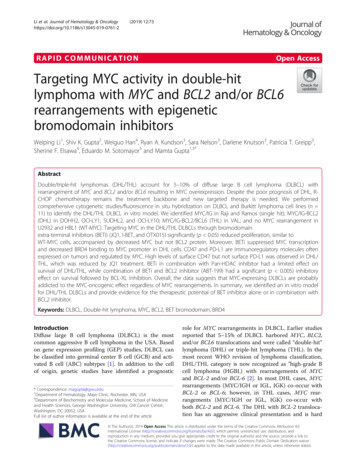
Transcription
Li et al. Journal of Hematology & 2019) 12:73RAPID COMMUNICATIONOpen AccessTargeting MYC activity in double-hitlymphoma with MYC and BCL2 and/or BCL6rearrangements with epigeneticbromodomain inhibitorsWeiping Li1, Shiv K. Gupta2, Weiguo Han4, Ryan A. Kundson3, Sara Nelson3, Darlene Knutson3, Patricia T. Greipp3,Sherine F. Elsawa4, Eduardo M. Sotomayor5 and Mamta Gupta1,5*AbstractDouble/triple-hit lymphomas (DHL/THL) account for 5–10% of diffuse large B cell lymphoma (DLBCL) withrearrangement of MYC and BCL2 and/or BCL6 resulting in MYC overexpression. Despite the poor prognosis of DHL, RCHOP chemotherapy remains the treatment backbone and new targeted therapy is needed. We performedcomprehensive cytogenetic studies/fluorescence in situ hybridization on DLBCL and Burkitt lymphoma cell lines (n 11) to identify the DHL/THL DLBCL in vitro model. We identified MYC/IG in Raji and Ramos (single hit); MYC/IG-BCL2(DHL) in DOHH2, OCI-LY1, SUDHL2, and OCI-LY10; MYC/IG-BCL2/BCL6 (THL) in VAL; and no MYC rearrangement inU2932 and HBL1 (WT-MYC). Targeting MYC in the DHL/THL DLBCLs through bromodomainextra-terminal inhibitors (BETi) (JQ1, I-BET, and OTX015) significantly (p 0.05) reduced proliferation, similar toWT-MYC cells, accompanied by decreased MYC but not BCL2 protein. Moreover, BETi suppressed MYC transcriptionand decreased BRD4 binding to MYC promoter in DHL cells. CD47 and PD-L1 are immunoregulatory molecules oftenexpressed on tumors and regulated by MYC. High levels of surface CD47 but not surface PD-L1 was observed in DHL/THL, which was reduced by JQ1 treatment. BETi in combination with Pan-HDAC inhibitor had a limited effect onsurvival of DHL/THL, while combination of BETi and BCL2 inhibitor (ABT-199) had a significant (p 0.005) inhibitoryeffect on survival followed by BCL-XL inhibition. Overall, the data suggests that MYC-expressing DLBCLs are probablyaddicted to the MYC-oncogenic effect regardless of MYC rearrangements. In summary, we identified an in vitro modelfor DHL/THL DLBCLs and provide evidence for the therapeutic potential of BET inhibitor alone or in combination withBCL2 inhibitor.Keywords: DLBCL, Double-hit lymphoma, MYC, BCL2, BET bromodomain, BRD4IntroductionDiffuse large B cell lymphoma (DLBCL) is the mostcommon aggressive B cell lymphoma in the USA. Basedon gene expression profiling (GEP) studies, DLBCL canbe classified into germinal center B cell (GCB) and activated B cell (ABC) subtypes [1]. In addition to the cellof origin, genetic studies have identified a prognostic* Correspondence: magupta@gwu.edu1Department of Hematology, Mayo Clinic, Rochester, MN, USA5Department of Biochemistry and Molecular Medicine, School of Medicineand Health Sciences, George Washington University, GW Cancer Center,Washington, DC 20052, USAFull list of author information is available at the end of the articlerole for MYC rearrangements in DLBCL. Earlier studiesreported that 5–15% of DLBCL harbored MYC, BLC2,and/or BCL6 translocations and were called “double-hit”lymphoma (DHL) or triple-hit lymphoma (THL). In themost recent WHO revision of lymphoma classification,DHL/THL category is now recognized as "high-grade Bcell lymphoma (HGBL) with rearrangements of MYCand BCL-2 and/or BCL-6 [2]. In most DHL cases, MYCrearrangements (MYC/IGH or IGL, IGK) co-occur withBCL-2 or BCL-6; however, in THL cases, MYC rearrangements (MYC/IGH or IGL, IGK) co-occur withboth BCL-2 and BCL-6. The DHL with BCL-2 translocation has an aggressive clinical presentation and is hard The Author(s). 2019 Open Access This article is distributed under the terms of the Creative Commons Attribution 4.0International License (http://creativecommons.org/licenses/by/4.0/), which permits unrestricted use, distribution, andreproduction in any medium, provided you give appropriate credit to the original author(s) and the source, provide a link tothe Creative Commons license, and indicate if changes were made. The Creative Commons Public Domain Dedication o/1.0/) applies to the data made available in this article, unless otherwise stated.
Li et al. Journal of Hematology & Oncology(2019) 12:73to treat with conventional chemotherapy [3, 4]. The clinical behavior of DHL with BCL-6 cases (MYC/BCL6) isnot well understood. With standard therapeutic approaches such as with rituximab, cyclophosphamide,doxorubicin, and vincristine (R-CHOP) [5], DHL/THLgroups have a prognosis worse than patients withoutMYC/IG rearrangements and the median overall survivalfor DHL/THL varied from 4.5 to 34 months [6–12].There are some DLBCLs in which MYC and BCL2 genesare overexpressed at the protein level, without geneticrearrangements. MYC protein expression is detected ina much higher proportion of DLBCL (around 40%) andis associated with concomitant expression of BCL-2 [13].This profile was referred to as the “double-expresser”phenotype in the revised WHO classification of lymphoid neoplasms [2, 3, 14]. The double-expresser lymphomas have a worse outcome than other DLBCLs butthey are not as aggressive as the HGBL, with rearrangements of MYC and BCL-2 and/or BCL-6 [3, 14].Despite the poor prognosis in DHL, R-CHOP remainsthe backbone of treatment; it is an area of active preclinical and early-phase clinical research for exploring novelapproaches for the treatment of difficult lymphomas.MYC and BCL2 translocations drive proliferation andprevent apoptosis in DHLs. We have previously shownthat MYC overexpression correlated with inferior eventfree survival in DLBCL [15]. MYC acts as a protooncogene and plays an important role in hematologiccancers such as aggressive B cell lymphoma [16] as wellas in a number of solid tumors [17–21]. Despite thewell-established role of MYC protein in driving cancercell growth, no direct MYC-targeted therapeutic agenthas advanced to the clinical setting for DHL and THLDLBCLs. Progress is being made in the targeting of theregulation of MYC activity by BET inhibitors in theMYC-expressing murine lymphoma or DLBCL cell lines[22–24]. However, very few studies described the BETprotein role specifically in DHL/THL model. Potent andselective small molecule inhibitors of BET bromodomainare being clinically evaluated to target MYC in severaldiseases [25]. Therefore, in this study, we sought to identify DHL/THL cell lines and understand the role of BETbromodomain inhibition alone or in combination withother therapies in DHL/THL DLBCL.Page 2 of 13antibiotics/antimycotics. Raji, Ramos (BL), and DOHH2cell lines were purchased from ATCC (Manassas, VA) andwere cultured in RPMI supplemented with 10% FBS.Antibodies and drugsAntibodies to c-MYC, BCL-6, BCL-2, BCL-XL, MCL-1,P21, BIM, and H3K27Ac were obtained from Cell Signaling Technology (Beverly, MA). Actin antibody waspurchased from Santa Cruz (Santa Cruz, CA, USA).BET inhibitor I-BET762 (referred to as I-BET), JQ1, andOTX015 and BCL-2 inhibitor ABT-199 were purchasedfrom Selleck Chemicals (Houston, TX, USA). HDAC inhibitor SAHA (vorinostat) was purchased from SigmaAldrich (St. Louis, MO, USA).Cytogenetic studies by FISHMYC, BCL2, and BCL6 rearrangements were analyzedusing break-apart FISH. The MYC (5′ red (R) /3′ green(G)), BCL2 (3′ G/5′ R), and BCL6 (3′ G/5′ R) probeswere commercially available from Abbott Molecular(Downers Grove, IL, USA). FISH was performed usingstandard FISH methodologies [26].Assessment of cell proliferationFor thymidine incorporation assay, 1.0 104 cells werecultured for 72 h with bromodomain extra-terminal inhibitors (BETi). Before harvesting, cells were pulsed with1 μCi (0.037 MBq) tritiated thymidine (3H-TdR; Amersham, UK) for 18 h and 3H-TdR incorporation levelswere determined using a Beckman scintillation counter(GMI). For XTT assay, 0.25 104 cells were cultured for72 h with BETi and XTT was added for 3 h followed byanalysis on a SpectraMax plate reader (Molecular Devices, San Jose, CA, USA).Cell survival by annexin V/PI staining5.0 105 cells/ml were cultured for 72 h in the absenceor presence of BET inhibitors, then stained using 1 μg/ml annexin V–FITC for 30 min at 4 C. Cells were thenwashed in annexin V binding buffer and stained with0.5 μg/ml propidium iodide and analyzed by flow cytometry (FACSCalibur; Becton Dickinson). Data analysis wasperformed with Flow Jo software (TreeStar).Western blottingMaterials and methodsHuman DLBCL cell linesThe B cell lymphoma cell lines OCILY10 (LY10), SUDHL2(DHL2) OCILY1(LY1), OCILy3, and OCILy19 were a kindgift from Dr. Louis Staudt (NCI, Bethesda, MD, USA).VAL and U2932 cell lines were kindly provided by Dr.Izzidore Lossos (University of Miami, Miami, FL, USA).All cell lines were grown in Iscove’s modified Dulbecco’smedium supplemented with 20% human serum andCells were lysed with RIPA buffer for 30 min on ice andlysates cleared by centrifugation, and Western blottingwas performed as described earlier [27].RNA isolation and RT-PCRTotal RNA was extracted using RNeasy mini kit (QIAGEN,Germantown, MD, USA). cDNA was synthesized usingtotal RNA with SuperScript III First-Strand SynthesisSuperMix (Invitrogen, Grand Island, NY, USA) according
Li et al. Journal of Hematology & Oncology(2019) 12:73to the manufacturer’s instructions. PCR was performed according to the HotStar Taq Master Mix kit instructions.The program consisted of 95 C for 15 min, 25 cycles of95 C for 15 s, 58 C for 30 s, and 72 C for 30 s, followedby 72 C for 10 min. The RT-PCR primers used were asfollows:c-MYC: cMyc-F (5′GGGTAGTGGAAAACCAGCAGCCTC3′)cMyc-R (5′CATCTTCTTGTTCCTCCTCAGAGTCGC3′).BCL6: BCL6-F (5′TAACATCGTTAACAGGTCCATGACG3′)BCL6-R (5′GCCCCGTTCTCACAGCTAGAATC3′)GAPDH: GAPDH-F (5′GAAGGTCGGAGTCAACGGATTTG3′)GAPDH-R (5′ATGGCATGGACTGTGGTCATGAG3′).Plasmid constructs and transient transfectionsPlasmid DNA (5 μg) for each of the pcDNA3, pcDNA3cMyc, or pcDNA3-BCL2 (addgene) was transfected usinga human B cell Nucleofector kit (Amaxa Biosystems).Briefly, 6 106 DLBCL cells were transfected using a U15 program on a Nucleofector equipment. Two days following transfection, cells were harvested and used for analyses as required.Chromatin immunoprecipitation (ChIP)ChIP assay was performed using the ChIP Assay Kit(EMD Millipore Billerica, MA, USA) with antibodies toBRD4 (Cell Signaling Technology, Cambridge, MA,USA) or IgG following the manufacturer’s instructions.Immunoprecipitated DNA and input were analyzed byPCR using the following primers: c-MYC promoter: F:5′-AACATGACCAGACTGCCTC-3′and R:5′-CTCAAAGCAAACCTCCTAC-3′; BCL6 promoter: F: 5′-CGTACATTCTCAGCTTATG-3′and R:5′-CTTACGCCTCTCTTTACTG-3′; and BCL2 promoter: F: 5′-CAAGGGGGAAACACCAGAATC-3′ and R:5′-CCCCCAGAGAAAGAAGAGGAG-3′.Flow cytometryCells (1 106 cells) were washed in FACS buffer (PBScontaining 2% FBS and 0.05% sodium azide) and incubated with PD-L1-PE conjugated and CD47-FITC conjugated or isotype control antibodies (mouse IgGκ-FITC/PE) (BD Biosciences, San Jose, CA, USA) for 30 min.Cells were washed with FACS buffer and re-suspendedin 500 μL FACS buffer, and data were acquired on aFACSCalibur flow cytometer (BD Biosciences). Data wasanalyzed using FlowJo version10 software.StatisticsThe data is presented as the mean standard error from3 independent experiments. An unpaired Student t testPage 3 of 13was used for statistical comparisons and a *p value 0.05 was considered significant.ResultsDetection of MYC rearrangements in human BL andDLBCL cell linesWe began our studies by evaluating MYC, BCL2, andBCL6 rearrangements in 11 B cell lines by fluorescencein situ hybridization (FISH) using MYC, BCL2, andBCL6 break-apart (BA) probes. Break-apart probes target two areas of a MYC, BCL2, and BCL6 gene sequence. Using the BA probe, U2932 showed no MYCrearrangement and showed two normal fusion signals,while translocation positive cells such as Raji, OCILY1,and Val had lost one of the normal fusion signals andhad separated red and green signals as shown in Fig. 1.Representative images showing MYC, BCL2, and BCL6rearrangements are depicted in Fig. 1. Based on theMYC, BCL2, and BCL6 rearrangements, DLBCL celllines were determined to fall into either wild-type MYC(WT-MYC) seen in HBL-1 and U2932 cell lines; singleMYC rearrangement with immunoglobulin commonlyreferred to as single hit (MYC/IG; SH) seen in Raji andRamos Burkitt lymphoma cell lines; MYC rearrangement with BCL2 gene (MYC/BCL2; DHL) seen inOCILY1, OCILY10, SUDHL2, and DOHH2 cell lines; orMYC rearrangements with both BCL2 and BCL6 genes(MYC/BCL2/BCL6; THL) seen in only VAL cell line(Table 1). We also identified a unique group with noMYC rearrangements and BCL2 and BCL6 translocations (BCL2/BCL6) in OCILy3 and OCILY19 cell lines.These classifications allowed us to examine the effect ofBET inhibition in DLBCL cell lines harboring MYC rearrangements occurring with BCL2 and/or BCL6.Anti-proliferative effect of BET inhibitors in DHL/THLDLBCL cellsMYC overexpression has been shown to be regulatedby BRD proteins in multiple cancer types [22, 28].We examined the sensitivity of BET bromodomainsmall molecule inhibitors (BETi) such as I-BET-762(I-BET), JQ1, or OTX015 (OTX) in DHL, THL, andSH cell lines harboring MYC rearrangement withBCL2 and/or BCL6. First, we assessed the effect oflow doses (0.5 and 1.0 μM) of the JQ1, I-BET, andOTX on DHL and THL cells along with WT-MYCcells. A limited anti-proliferative effect was seen withthe low doses of these inhibitors on these cells anddid not reach to LD50 (Additional file 1: Figure S1).Next, we increased the doses of JQ1, I-BET, and OTXto 2.5 and 5.0 μM and assessed the anti-proliferative effect in WT-MYC, MYC/IG, BCL2/MYC, MYC/BCL2/BCL6, and BCL2/BCL6 rearrangements. Raji cell line,
Li et al. Journal of Hematology & Oncology(2019) 12:73Page 4 of 13Fig. 1 Identifications of double hit and triple hit in DLBCL and BL cell lines by FISH. MYC, BCL2, and BCL-6 rearrangements were detected by FISHusing break-apart probes carried out in DLBCL cell lines (n 9) and BL cell line (n 2). Representative images of c-MYC, BCL-2, and BCL-6 FISH inDLBCL and BL cell lines are shown. Images of U2932 (a-c) indicate a normal 2-fusion (f) signal pattern for MYC, amplification of BCL-2, and 4F forBCL6. LY1 MYC 1R1ampR2F, BCL-2 3R2G, and BCL-6 3F (d-f). VAL MYC 3R1G2F, BCL-2 3R1G1F, and BCL-6 1R1G1F (g-i). LY3 MYC 3F, BCL-2 1R1G1F,and BCL-6 1R2F (j-l). Raji MYC 1R1G1F, BCL-2 3F, and BCL-6 2F (m-o)Table 1 Identification of MYC, BCL-2, and BCL-6 rearrangements in human DLBCL and BL cell lines: c-MYC, BCL-2, and BCL-6rearrangements were analyzed with break-apart FISH in human DLBCL (n 9) and Burkitt Lymphoma cell lines (n 2)DLBCL cell on3–4 copiesWT-MYCHBL-1Wild-type3 copiesNormalWT-MYCRaji (BL)Rearrangement3 copiesNormalSingle hitRamos (BL)Rearrangement1 copy3 copiesSingle hitSUDHL2Rearrangement/amplificationRearrangement3 copiesDouble hitOCILY1Rearrangement/amplificationRearrangement3 copiesDouble 3 copiesDouble rmalDouble e hitOCILY33–4 copiesRearrangementRearrangementBCL2/BCL6 translocationOCILY193–4 copiesRearrangementRearrangementBCL2/BCL6 translocation
Li et al. Journal of Hematology & Oncology(2019) 12:73which harbors a single MYC rearrangement, was themost sensitive to I-BET, JQ1, and OTX with nearly 95%inhibition of thymidine incorporation (Fig. 2a–c). DHLcell lines LY1, LY10, and DHL2 and THL cell line Valwere also sensitive to I-BET, JQ1, or OTX, although theoverall effect of BETi was less robust than Raji cells butcomparable to U2932, which lack MYC rearrangements(Fig. 2a–c). These results suggest that double-hit andtriple-hit DLBCL cell lines are sensitive to BET bromodomain inhibitors and the anti-proliferative effect iscomparable to cells expressing no MYC rearrangements.Page 5 of 13BET bromodomain regulates MYC and BCL6 but not BCL2protein in DHL/THL DLBCLsTo gain insight into changes in MYC, BCL-2, and BCL-6expression levels in response to BET inhibitors, WTMYC (U2932), SH (Raji), DHL (LY1, DHL2), and THL(VAL) expressing human DLBCL lines were treated withvarious doses of I-BET, JQ1, or OTX. We consistentlyobserved a potent, concentration-dependent decrease inMYC protein expression, across the panel of cell linestested, suggesting that BETi suppress MYC regardless ofMYC rearrangement status (Fig. 3a, b). Interestingly,Fig. 2 Anti-lymphoma activity of BET bromodomain inhibitors on the DHL/THL cells. a–c WT- MYC, SH, DH, and TH harboring DLBCL cell lineswere treated with 3 pharmacological BET bromodomain inhibitors I-BET (a), JQ1 (b), and OTX (c) for 72 h and proliferation was assessed by H3thymidine incorporation assay. Data represent mean SD from three independent experiments. p 0.05 value was significant for both theconcentrations in all the cell lines tested
Li et al. Journal of Hematology & Oncology(2019) 12:73Page 6 of 13Fig. 3 BET inhibition suppresses MYC and BCL6 protein expression in DHL/THL cells. a, b WT-MYC, SH DHL, and THL harboring DLBCL cell lineswere treated with JQ1, I-BET, and OTX, and protein expression was assessed by western blotting. Experiments were repeated three times and arepresentative western blot image is shownunlike MYC expression, the expression of BCL2 wascompletely insensitive to I-BET, JQ1, and OTX-015treatment (Fig. 3a, b). However, like MYC expression,BCL6 expression was abolished following treatment withBETi in all the cell lines tested (Fig. 3a, b). These resultsindicate that MYC and BCL6 (but not BCL2) are regulated by BET bromodomain and can be potentially targeted by BET inhibitors.Effect of BET inhibition on MYC and BCL-6 transcriptionWe next sought to examine the transcriptional changesin MYC and BCL-6 mRNA induced by BET inhibitors inDLBCL cell lines with MYC rearrangements. Variable effects were observed on MYC expression following IBET, JQ1, and OTX treatment in DHL2 and VAL celllines. Val cells (THL) showed robust MYC mRNA suppression by I-BET, JQ1, and OTX as compared to thatobserved in LY1 (DHL) (Fig. 4a, b). However, BCL6mRNA expression was equally suppressed by BETi inLY1 and Val cell lines (Fig. 4a, b). These results suggestthat BET protein regulates the expression of both MYCand BCL6 and the impact of BET inhibition on proliferation (Fig. 2) of DHL and THL cells may be manifestedby the coordinated loss of MYC and BCL6.Mechanistically, BETi interfere with MYC transcription by physically blocking binding of BRD proteins atregulatory elements that influence MYC expression. Weanalyzed the recruitment of BRD4 to the MYC promoterby ChIP assay and found that BRD4 was enriched at theMYC, BCL2, and BCL6 promoter regions (Fig. 4c, d).Treatment with I-BET decreased BRD4 binding at theMYC promoter in both DHL and THL cell lines. Likewise, BRD4 binding to the BCL6 promoter region inTHL cell line was also decreased. However, BETi had noeffect on BRD4 binding to BCL2 promoter region in anyof the cell lines tested (Fig. 4c, d). Taken together, thesedata indicate that BET inhibition directly modulatesMYC and BCL6 (but not BCL2) transcription potentiallyvia decreasing BRD4 recruitment to the promoter regionof MYC and BCL6.
Li et al. Journal of Hematology & Oncology(2019) 12:73Page 7 of 13Fig. 4 MYC and BCL-6 transcription is regulated by BET bromodomain protein in DHL/THL cells. a, b DHL and THL cell lines were treated withBET bromodomain inhibitors I-BET, JQ1, and OTX, and RT-PCR was performed using MYC- and BCL-6-specific primers. c, d ChIP assay wasperformed in the I-BET-treated DHL (LY1) and THL (Val) cells using BRD4 antibody, and RT-PCR was performed using MYC promoter primers.Experiments were repeated three times and a representative image is shownEffect of BET inhibitors on survival of DHL and THL cellsWe extended the study of BET inhibition to examine theeffect on survival of DHL/THL DLBCL cell lines. DLBCLcell lines expressing WT-MYC (U2932), SH (Raji), DHL(LY1, DHL2), and THL (VAL) were treated with variedconcentrations of I-BET, JQ1, or OTX015 and then analyzed for survival fraction of cells by excluding annexin V/propidium iodide-stained cells. Surprisingly, unlike cellproliferation data, BET inhibition had only a modest effecton cell survival for cell lines tested (Fig. 5). Cell lines expressing WT-MYC, MYC/IG, or BCL2/BCL6 rearrangements exhibited approximately 20–30% reduction in cellsurvival at 5 μM dose of BETi, while same dose of BETi inDHL and THL lines demonstrated only 10–15% reductionin cell survival (Fig. 5a–c). There was no significant difference in cytotoxic effects among various BETi used on anygiven cell line. These results suggest that despite the robust anti-proliferative effects of BETi in DHL/THL celllines, BETi had only a modest effect on cell viability inDHL and THL DLBCL cells.Effect of BET inhibitors on immunoregulatory proteinsCD47 and PD-L1 in DHL/THL cellsIt has been shown in some cancer cell lines that suppression of MYC with BET inhibitors such as JQ1 reduced programmed cell death ligand 1 (PD-L1) and CD47 expression[29]. We sought to determine the effect of BETi on the PDL1 and CD47 expression in DHL/THL cells. First, weexamined the surface PD-L1 expression in WT-MYC(U9372), DHL (DOHH2), and THL (Val) cell lines by flowcytometry. Surprisingly, WT-MYC and DHL cells did notexpress surface PD-L1 as compared to isotype control.However, the THL (Val) cells express very low levels of PDL1 (Fig. 6a). This low level of PD-L1 expression was notchanged upon treatment with JQ1 or I-BET (Fig. 6b).When we examined CD47 expression in these cells, wefound a robust surface CD47 expression in all cells, whichwas reduced upon treatment with JQ1 (Fig. 6c). Taken together, these results show that BETi reduces CD47 expression on DLBCL regardless of translocation status whilehaving no effect on PD-L1 expression in THL (Val) cells.
Li et al. Journal of Hematology & Oncology(2019) 12:73Page 8 of 13Fig. 5 Effect of BET inhibitors on the survival of DHL and THL cells. a–c WT-MYC, SH, DHL, THL, and BCL-2/BCL-6 translocation harboring cell lineswere treated with 3 different pharmacological BET bromodomain inhibitors I-BET (a), JQ1 (b), and OTX (c) for 72 h and cell survival was assessedby flow cytometry after annexin V/PI staining. Data represent mean SD from three independent experiments. p 0.05 value was significant forboth the concentrations in all the cell lines testedEffect of co-treatment with inhibitors of BET and HDACon DHL/THL DLBCL cellsBETi mediated transcriptional repression of MYC orBCL6 appears to have little effect on survival of DHL orTHL DLBCL cells despite robust anti-proliferative activity.Next, we sought to determine if BETi can sensitize cells toHDAC inhibition. WT-MYC (U2932), MYC/BCL2-(LY1),and MYC/BCL2/BCL6 (VAL) DLBCL cell lines weretreated with or without suboptimal concentrations ofSAHA, I-BET, or their combination for 72 h and analyzedfor cell proliferation and survival. As shown in Fig. 7a–c,the 2.5 μM concentration of SAHA, a Pan-HDAC inhibitor had a significant anti-proliferative effect in U2932(WT-MYC) cell line; it remained ineffective in LY1 (DHL)or Val (THL), while 2.5 μM I-BET suppressed the proliferation in all three cell lines. Combining SAHA with I-BETfurther reduced the proliferation in U2932, LY1, and Valwith WT-MYC, DHL, and THL status, respectively (Fig.7a–c). We then evaluated the effect of SAHA and I-BETon cell survival and observed that SAHA or BETi usedalone had only a modest decline in cell survival for theWT-MYC cells; the combination had no further change incell survival in any of the MYC rearrangement DLBCL celllines tested (Fig. 7d–f).We next sought to determine the mechanisms of BETiand HDACi combination effect on cell proliferation of
Li et al. Journal of Hematology & Oncology(2019) 12:73Page 9 of 13Fig. 6 Effect of I-BET and JQ1 on cell surface expression of CD47 and PD-L1 on WT, DHL and THL cells. a Cells (0.5 106) from wild-type MYC(U2932), double-hit (DOHH2), and triple-hit (Val) B cell lines were harvested, and PD-L1 expression was determined by flow cytometry. b Val(0.5 106) cells were treated with I-BET (10 μM), JQ1 (10 μM), or DMSO control. After 24 h, cells were harvested and the effects on PD-L1 wereinvestigated by flow cytometry. c Cells (0.5 106) from U2932, DOHH2, and Val were treated with JQ1 (10 μM) or DMSO control. After 24 h,cells were harvested and CD47 expression was determined by flow cytometryDHL and THL cells. We performed the western blotanalysis in DLBCL cell lines harboring WT-MYC, MYC/BCL2, or MYC/BCL2/BCL6 rearrangements and testedthe impact of combination on histone acetylation(H3K27AC) and the cell cycle regulator P21. As expected, treatment with SAHA increased levels of H3K27acetylation and P21, combining BETi and SAHA furtherincreased the P21 level in WT-MYC, DHL, and THLcells (Fig. 7g). We have also tested the BETi and HDACicombination effect on antiapoptotic proteins such asBCL-XL and MCL-1. A modest decline in the BCL-XLlevels but not in the MCL-1 levels was observed WTMYC, DHL, and THL cells with either drug alone; however, combination further decreased the BCL-XL levelonly in WT-MYC cells (Fig. 7g). Interestingly, neitherSAHA nor I-BET alone or their combination had any inhibitory effect on BCL2 or BIM protein expression (datanot shown). These results suggest that Pan-HDAC inhibitor SAHA synergizes and potentiates anti-proliferative effects of I-BET in DLBCL cell lines via P21 upregulationand histone acetylation despite differences in MYC rearrangement status.Effect of combined targeting of BET and BCL2 in DHL/THLDLBCL cellsSeveral studies have shown the role of BCL-2 in cancercell survival and drug resistance [30, 31]. We observed ahigh basal level of BCL-2 protein in DHL and THLDLBCL cell lines, which was not inhibited by BET bromodomain inhibitors (Fig. 4). Since BCL-2 has beenshown to suppress apoptosis in a variety of cell types, wesought to determine if BETi has synthetic lethality withBCL-2 responsible for survival in DLBCL cell lines withvarious MYC rearrangements. Despite the robust anti-
Li et al. Journal of Hematology & Oncology(2019) 12:73Page 10 of 13Fig. 7 Anti-proliferative effect of combined inhibition of BET and HDAC in DHL and THL. a–f WT-MYC (U2932), DHL (LY1), and THL (Val) DLBCLcell lines were treated with I-BET alone, SAHA alone, and combination of both and proliferation and survival analyzed by H3-thymidineincorporation and annexin/PI, respectively. g The effect on P21, H3K27AC, BCL-XL, and MCL-1 expression was determined by western blotting. Barrepresents mean SD from three separate experiments. p 0.05, **p 0.01proliferative effect of BETi in DLBCL cell lines, BETi(JQ1) alone had only a limited effect on cell survival,while a pro-apoptotic effect of BCL-2 inhibitor (ABT199) varied with nearly 90% decreased survival of WTMYC cell line U2932 and the DHL cell line DOHH2 ascompared to a relatively moderate 50% decreased survival in THL cell line Val. Co-treatment with I-BET andABT-199 had a strong combinatorial effect with nearlycomplete abolition of cell survival not only in WT-MYCcell line but also DHL (DOHH2) and THL (Val) DLBCLcell lines (Fig. 8a–c). Collectively, these findings demonstrate that treatment with the BETi sensitizes DHL andTHL DLBCL cells to BCL-2 antagonist ABT-199.BCL-2 and related anti-apoptotic proteins BCL-XL orMCL-1 reduce apoptosis by neutralizing pro-apoptoticBCL-2 family members, including BIM and BCL-Xs,and enhance cell survival. To examine the effect of BETand/or BCL2 inhibition on BCL-2 family members, weassessed the effects of suboptimal doses of I-BET andABT-199 alone or their combination on levels of antiapoptotic BCL2 family members BCL-XL and MCL-1and pro-apoptotic member BIM in WT-MYC (U2932)and MYC/BCL-2/BCL-6 (Val) cell lines. The combination of both drugs reduced BCL-XL and MCL-1 levelsmore than either single agent alone in WT and THL;however, no changes were seen in BIM levels at thedoses used in all the cell lines tested (Fig. 8d). Overall,these findings suggest that BETi, in combination withBCL-2 inhibitors, will be effective in targeting DHL orTHL DLBCL cells.DiscussionThe median overall survival of patients with DHL/THLDLBCLs treated with R-CHOP has been reported to be
Li et al. Journal of Hematology & Oncology(2019) 12:73Page 11 of 13Fig. 8 Combinatorial effect of BET and BCL-2 inhibitor ABT-199 on WT-MYC and THL. a–c WT-MYC (U2932), DHL (DOHH2), and THL (Val) weretreated with JQ1 alone (5 μM), a sublethal dose of ABT-199 alone (500 nM), or a combination of both, and survival assay was performed byannexin/PI staining. d WT-MYC (U2932) and THL (Val) cells were treated with I-BET (2.5 μM), ABT-199 (500 nM), and a combination of both, andthe effects on BCL-XL, BCL-2, BIM, and MCL-1 proteins were investigated by western blotting using specific antibodies. Bar represents mean SDfor three replicates from three different experiments. *p 0.05, **p 0.01, ***p 0.0055 to 24 months [8], and there is an unmet need for alternative therapeutic strategies for this subgroup. MYCprotein has been considered “undruggable” and themain approach has been directed at interfering withMYC:MAX dimerization [32, 33]. In various cancers,MYC-dependent transcription requires the critical transcriptional assembly and/or chromatin-modifying enzyme complexes influencing cell division and survival[34, 35]. Bromodomains recognize acetylated lysine inhistone tails and activate transcription and function asepigenetic readers. A large number of studies were published showing the efficacy of the BET pharmacologicalinhibitors, in a B-ALL and multiple myeloma [22, 36].BET pharmacological inhibitors such as I-BET151(GSK1210151A) which was reported as a novel BETbromodomain inhibitor that had proved its efficacy inmixed-lineage l
0.5μg/ml propidium iodide and analyzed by flow cytom-etry (FACSCalibur; Becton Dickinson). Data analysis was performed with Flow Jo software (TreeStar). Western blotting Cells were lysed with RIPA buffer for 30min on ice and lysates cleared by centrifugation, and Western blotting was performed as described earlier [27]. RNA isolation and RT-PCR
